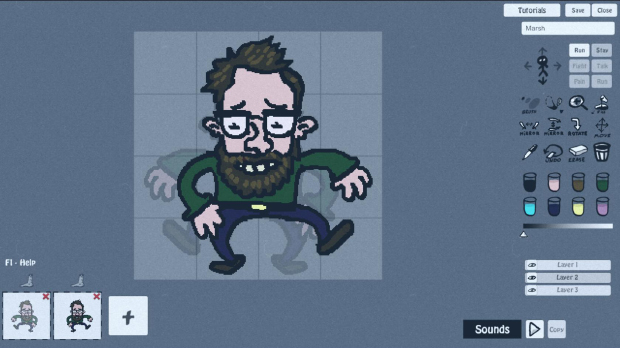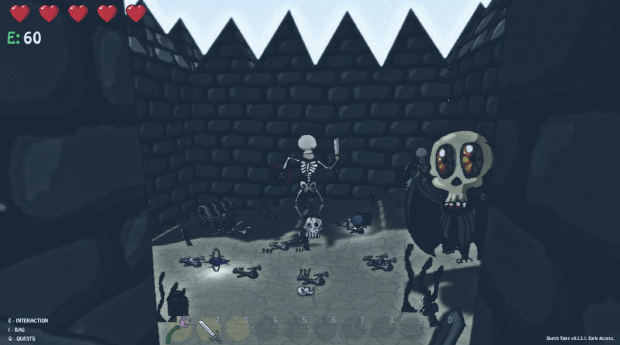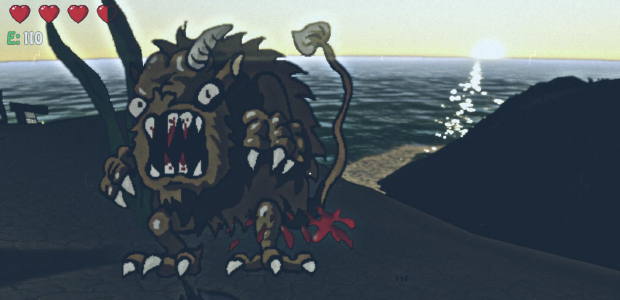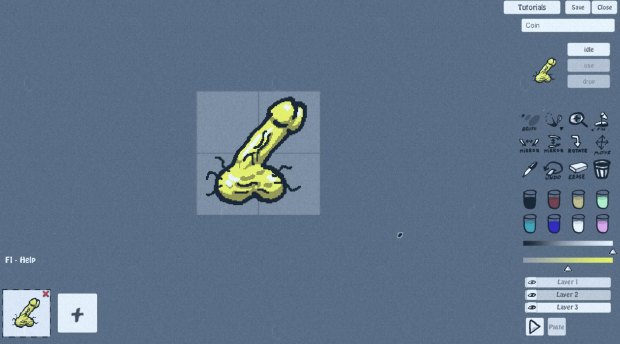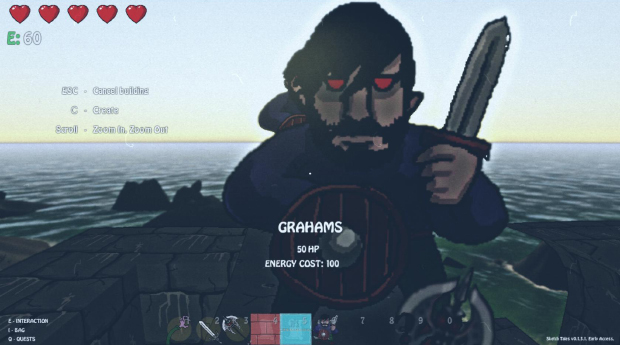Premature Evaluation: Sketch Tales
Well-hung, drawn and slaughtered
Each week Marsh Davies turfs through the crude doodles of Early Access and comes back with any masterpieces-in-the-making he can find and/or amends his discoveries with an enthusiastically rendered dick or two. This week there is ample opportunity to append such appendages in Sketch Tales, a firstperson hack-n-slash in which you’re encouraged to re-draw and animate everything on the island you inhabit. I’m guessing the name “Tales from Penis Island” didn’t make it past Steam’s terms of service.
A decade ago, I made the farsighted strategic decision to offset my vulnerability to the continuing economic decline of the UK by splitting my career into two equally unsuccessful careers: one as a writer and the other as an illustrator. So it’s only natural that commissioning editors assume I should like the sorts of games where you build and draw stuff - like penises or whatever. However, it turns out that the one thing I like more than drawing a proud, pulsing dingdong is being paid for it, and so these DIY games tend to combine a guilty sense of unprofitableness with tools that aren’t as good as the ones I comfortably use every day.
Sketch Tales’ tools are, in this context, a mixed bag. After a short animation outlines how the world was sapped of colour and your quest to return it, the tools are the first thing you encounter. There are aspects of them I like: the low resolution and the ovular, angled nib of your brush forces an inexactness upon your work that both matches the rest of the game and prevents you from pointlessly and time-consumingly over-rendering. The requirements for each sprite are laid out intelligently, prompting you to draw it from the various perspectives at which it might be seen and suggesting the sort of animations and sounds it will require - for attacking, reacting to pain and so forth - but the game will make do without these if you get bored and decide to skimp. It also does an adequate job of presenting multiple frames for the purpose of animation and - the biggest boon of all - it saves it all away neatly without you having to fuss over filenames or export spritesheets.
Colour-picking, however, is peculiar and restrictive, seemingly only allowing you to select saturation and lightness levels within a small number of hues. There is no orange in Sketch Tales. Nor can you easily manipulate parts of drawings: there is no select tool with which to shift a limb for a new frame of animation, for example. You must redraw, then recolour, and, currently, the fill tool is somewhat buggy, making the entire process rather more time-consuming than it needs to be - and animation is already one of the most famously time-consuming creative endeavours you can pursue.
And it is only after a good deal of time has been consumed drawing and animating my avatar that I remember that this is a first person game and I will only ever see it on an inventory screen. Still, I am pleased with my self-portrait, which accurately mimics my trademark bow-backed scuttle and limp-wristed flailing. Oddly, at this stage you can’t edit the hands you will actually see in firstperson - instead you must collect sprites such as these in the form of scrolls, dotted around the game world. Individual items can also be edited when stuffed into your inventory, but scrolls will allow you to spawn your creations at will (although the rate is restricted by a replenishing mana pool).
The game then opens inside a jail, wherein a black spiny creature jibbers about retrieving a coin from a bridge and restoring a fountain which will somehow help bring back colour to the world. It is indeed very grey, and given a further noisy grey overlay to give the impression of old film stock. In fact, it is so grey that, at night, the textures lack sufficient contrast to permit easy navigation. An incentive, if there were none other, to fulfill your quest.
First I must escape from prison, and, surprisingly, this is as simple as going up to the bars and pressing ‘E’. I run into a spot of bother with a ferocious little potato-man, and though I’m not sure if he’s a fellow inmate or a jailer, I punch him with my placeholder hands until his sprite spirals across the room and explodes into bones and meat. Combat is hard to judge - the effective range of attacks is unclear and the health pool of your opponent or their level of threat is never indicated. At least it demonstrates how important feedback is in animation: many of the creatures don’t have pain frames, making it difficult to tell when they’ve been hit.
I do admire the voice work, though. You can supply your own soundclips as well as drawings, and the developers have done so with gusto, cackling, snorting and chirruping away. Some creatures emit rather beautiful chimes and someone in the jail periodically takes up the harmonica. The world is otherwise soundtracked with a strange and uneasy music, dissonant and sparse. It’s a fine, if sinister, accompaniment to exploration, but perhaps a little too repetitive to adequately cover the large amounts of time spent drawing.
Scrolls aren’t hard to come by, and quite quickly I have replaced my stumpy little hands with the sort of malformed claws you get after years of holding a Wacom pen and redrawn the potato man as a disembodied horror-head. Disappointingly, this doesn’t immediately transform all instances of potato-men already in the world, and so the only way you get to see your creation in motion is to spawn it yourself. (I am, however, too kind a man to introduce more of this horror upon an already troubled land.) This is doubly a shame, because it means that your ambition to bring colour back to the world does not affect the existing geometry, and though you find scrolls that allow you to place blocks, ramps, stairs and much more, your elaborate structures will most likely be dwarfed by the greyscale landscape they sit within.
Looming over it all is the fabled bridge - although currently in such a state of disrepair that it doesn’t really adequately fulfil that title. Just to get onto it, I need to build a substantial winding ramp, which is made slightly trickier by the framerate’s inversely proportional relationship to my altitude. I tumble from the bridge and die, but the only punishment is to respawn in prison and I’ve already built a ramp which gives me an easy escape-route from my cell. This is fortunate, as I respawn there multiple times as I work my way through the bridge’s formidable but ungratifying gauntlet of fights - a grim reaper; a floating, snake-fringed eye; and a skull on a foot. This is made all the harder by a bug which sometimes spawns a still-living duplicate of the monster you have just slain. But eventually I get by and loot the treasure chests therein. A gold coin! In celebration, I edit it to resemble a shiny golden penis (forgive me, but I have been very restrained so far) and then somehow trigger a cutscene which I confess I do not comprehend in the slightest.
The cutscene seems to imply the end of the current content but the game lets me continue all the same. My quest suggested I locate the fountain, but I scour the island and find nothing that resembles one. Other, non-hostile inhabitants offer me quests, but they all seem to involve killing something, and that has largely proved to be a joyless process. However, I read on the game’s website that you can spawn creatures to do your fighting for you. Does that mean any creature I spawn is friendly to me? I sort through my available scrolls, until I find a monster with a high mana requirement, which I take as an indication of its might. I rename it Graham and attempt a drawing to match his stoic, noble countenance and the blood red embers of his eyes. I resist adding a cock to him in case that makes things weird.
I spawn several Grahams (a fleet of Grahams? A scotch of Grahams?) and set upon a Skull-Foot, only to find myself betrayed by those very Grahams to which I had given life. “Why, Grahams, why?” I yell as I fall beneath those baleful red eyes.
And so, back to the paradox at the heart of so much user-generated content: Sketch Tales rewards those with an inclination to creativity but then directs it, via limited but WYSIWYG tools, into a pursuit which is ultimately isolated from the wider world. Whether or not this satisfies depends on how content you are to create things for your pleasure alone (or, alternately, how successful your YouTube channel is). For myself, the act of creation would have to be tied into the broader purpose and mechanical liberation of the world. As it stands, Sketch Tales’ RPG-lite questing falls short of tying these things together, so, for now, I might just keep my pixelly penises for those who pay.
Sketch Tales is available from Steam for £7. I played version 0.1.3.1 on 26/11/2015.


![The reverse has also occurred, of course, as was the case with Brett Murray’s satirical painting The Spear, which depicts Jacob Zuma, the President of South Africa, posing as Lenin with his (generously proportioned) dick dangling out. It may not be a terribly subtle critique, but it seems more than a simply puerile depiction when taken in the context of Zuma’s polygamy and publically espoused belief that a post-coital shower can protect you from HIV. Amusingly, Zuma’s response offered really quite a close reading of the work: “The portrait depicts me in a manner that suggests I am a philanderer, a womaniser and one with no respect. [It] is meant to convey a message that I am an abuser of power, corrupt and suffer political ineptness.” We really do bring our own unique perspective to art, don’t we?](https://www.rockpapershotgun.com/images/15/nov/sketchtalespe3.jpg)
